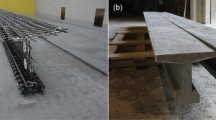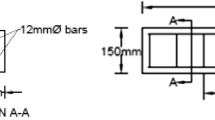Abstract
Purpose
The properties of fibre-reinforced polymer (FRP) composites have led to a significant increase of civil engineering applications based on the usage of these materials. In the construction sector, FRP are mainly used for strengthening existing buildings, thus creating the possibility of avoiding the environmental problems resulting from demolishing these structures and constructing new ones. In the light of this new opportunity, the present paper aims at evaluating and comparing the environmental performances of an unstrengthened reinforced concrete (RC) beam with those of different carbon fibre-reinforced polymer (CFRP) flexural strengthening techniques.
Methods
The paper uses Life Cycle Assessment (LCA) methodology in order to determine the most environmentally friendly solution in the case of an existing RC beam which does not properly satisfy the structural demands. The authors have decided to use the Cradle-to-Gate LCA type of study, considering that the primary goal of the paper is to establish whether strengthening and reusing an existing RC beam can be considered a more viable environmentally friendly proposal in contrast with demolishing the existing structural element and constructing a new one. The following impact categories are used with the purpose of achieving a clear understanding of the products’ environmental influence: Climate Change, Human Toxicity, and Ozone Depletion. Their environmental performances are evaluated using the GaBi 6 software.
Results and discussion
The obtained results show that all the assessed CFRP strengthening solutions have a significantly lower environmental impact in comparison with those of the RC beam. In the case of the analysed RC structural element, the highest impact is attributed to the manufacturing stage of the cement and to the steel reinforcements. In most of the CFRP strengthening schemes, the environmental impact is mainly influenced by the amount of component materials (fibre and resin) used for manufacturing the considered composite elements.
Conclusions
The resulted values for the environmental parameters in the assessed case studies encourage the authors to assert that the usage of composite materials in specific civil engineering applications can represent an environmentally friendly solution. The environmental aspect of sustainability can thus be achieved in this industry by using particular FRP strengthening applications. Moreover, the negative effects of modern society over Earth can be reduced. The paper concludes that the usage of composite materials can represent an important step towards the sustainable development of the construction sector.






















Similar content being viewed by others
References
Bingel P, Bown A (2009) Sustainability of masonry in construction. In: Khatib JM (ed) Sustainability of construction materials. Woodhead, Cambridge, pp 82–119
Ciobanu PV (2014) Strengthening reinforced concrete beams with near surface mounted composite materials. PhD Thesis, Faculty of Civil Engineering and Building Services, “Gheorghe Asachi” Technical University of Iasi, Romania (in Romanian)
Ding GKC (2014) Life cycle assessment (LCA) of sustainable building materials: An overview. In: Pacheco-Torgal F, Cabeza LF, Labrincha J, de Magalhaes A (eds) Eco-efficient construction and building materials. Life cycle assessment (LCA) eco-labelling and case studies. Woodhead Publishing Limited, Cambridge, pp 38–62
Dumitrescu L, Maxineasa SG, Simion IM, Taranu N, Andrei R, Gavrilescu M (2014) Evaluation of the environmental impact of road pavements from a life cycle perspective. Environ Eng Manag J 13(2):449–455
EN 15804 (2012) Sustainability of construction works—environmental product declaration – core rules for the product category of construction products
Estrada H, Borja DH, Lee L (2012) Sustainability in infrastructure design. In: Jain R, Lee L (eds) Fiber reinforced polymer (FRP) composites for infrastructure applications. Springer Science+Business Media B.V., Dordrecht, pp 23–52
European Commission – Joint Research Centre – Institute for Environment and Sustainability (2011) International Reference Life Cycle Data System (ILCD) Handbook—Recommendations for Life Cycle Impact Assessment in the European context, EUR 24571 EN. Publications Office of the European Union, Luxemburg
Ewing B, Moore D, Goldfinger S, Oursler A, Reed A, Wackernagel M (2010) Ecological footprint atlas 2010. Global Footprint Network, Oakland, http://www.footprintnetwork.org/images/uploads/Ecological_Footprint_Atlas_2010.pdf
Gursel AP, Masanet E, Horvath A, Stadel A (2014) Life-cycle inventory analysis of concrete production. A critical review. Cem Concr Comp 51:38–48
Habert G (2014) Assessing the environmental impact of conventional and ‘green’ cement production. In: Pacheco-Torgal F, Cabeza LF, Labrincha J, de Magalhaes A (eds) Eco-efficient construction and building materials. Life cycle assessment (LCA) eco-labelling and case studies. Woodhead Publishing Limited, Cambridge, pp 199–238
Hirst N (2013) Building and climate change. In: Yao R (ed) Design and management of sustainable built environments. Springer, London, pp 23–30
Ibbotson S, Kara S (2013) LCA case study. Part 1: cradle-to-grave environmental footprint analysis of composites and stainless steel I-beams. Int J Life Cycle Assess 18:208–217
Ingrao C, Lo Giudice A, Tricase C, Mbohwa C, Rana R (2014) The use of basalt aggregates in the production of concrete for the prefabrication industry: environmental impact assessment, interpretation and improvement. J Clean Prod 75:195–204
ISO (2006a) Environmental management – life cycle assessment—principles and framework (ISO 14040:2006). The International Organization for Standardization (ISO), Geneva
ISO (2006b) Environmental management – life cycle assessment—requirements and guidelines (ISO 14044:2006). The International Organization for Standardization (ISO), Geneva
Knoeri C, Sanye-Mengual E, Althaus H-J (2013) Comparative LCA of recycled and conventional concrete for structural applications. Int J Life Cycle Assess 18:909–918
Marinkovic SB, Malesev M, Ignjatovic I (2014) Life cycle assessment (LCA) of concrete made using recycled concrete or natural aggregates. In: Pacheco-Torgal F, Cabeza LF, Labrincha J, de Magalhaes A (eds) Eco-efficient construction and building materials. Life cycle assessment (LCA) eco-labelling and case studies. Woodhead Publishing Limited, Cambridge, pp 239–266
Maxineasa SG, Taranu N (2013) Traditional building materials and fibre reinforced polymer composites. A sustainability approach in construction sector. Bulletin of the Polytechnic Institute of Iasi Construction and Architecture Section LIX(LXIII):55–68
Messari-Becker L, Bollinger K, Grohmann M (2013) Life-cycle assessment as a planning tool for sustainable buildings. In: Strauss A, Frangopol DM, Bergmeister K (eds) Life-cycle and sustainability of civil infrastructure systems. Proceedings of the Third International Symposium on Life-Cycle Civil Engineering (IALCCE 2012), Taipei, pp 1558–1562
Miller A, Ip K (2013) Sustainable construction materials. In: Yao R (ed) Design and management of sustainable built environments. Springer, London, pp 341–358
Motavalli M, Czaderski C, Schumacher A, Gsell D (2010) Fibre reinforced polymer composite materials for building and construction. In: Pohl G (ed) Textiles, polymers and composites for buildings. Woodhead Publishing Limited, Cambridge, pp 69–129
Napolano L, Menna C, Asprone D, Prota A, Manfredi G (2015) LCA-based study on structural retrofit options for masonry buildings. Int J Life Cycle Assess 20:23–35
Nebel B (2006) White paper – life cycle assessment and the building and construction industry. Prepared for Beacon Pathway Limited, Auckland http://www.beaconpathway.co.nz/images/uploads/White_Paper_TE200_Life_Cycle_Assessment.pdf
Pacheco-Torgal F, Labrincha JA (2013) The future of construction materials research and the seventh UN Millennium. Development goal: a few insights. Constr Build Mater 40:729–737
Pacheco-Torgal F (2014) Introduction to the environmental impact of construction and building materials. In: Pacheco-Torgal F, Cabeza LF, Labrincha J, de Magalhaes A (eds) Eco-efficient construction and building materials. Life cycle assessment (LCA) eco-labelling and case studies. Woodhead Publishing Limited, Cambridge, pp 1–10
Rossi B (2014) Discussion on the use of stainless steel in constructions in view of sustainability. Thin Wall Struct 83:182–189
Simion IM, Ghinea C, Maxineasa SG, Taranu N, Bonoli A, Gavrilescu M (2013) Ecological footprint applied in the assessment of construction and demolition waste integrated management. Environ Eng Manag J 12(4):779–788
Solis-Guzman J, Martinez-Rocamora A, Marrero M (2014) Methodology for determining the carbon footprint of the construction of residential buildings. In: Muthu SS (ed) Assessment of carbon footprint in different industrial sectors, vol 1. Springer Science+Business Media, Singapore, pp 49–83
Stocker TF, Qin D, Plattner G-K, Tignor MMB, Allen SK, Boschung J, Nauels A, Xia Y, Bex V, Midgley PM (2013) Climate Change 2013: The physical science basis. Contribution of Working Group I to the Fifth Assessment Report of the Intergovernmental Panel on Climate Change. Cambridge University Press, Cambridge and New York
Taranu N, Oprisan G, Ioana E, Budescu M, Munteanu V, Taranu G (2012) Composite and hybrid solutions for sustainable development in civil engineering. Environ Eng Manag J 11(4):783–793
Taranu N, Ciobanu P, Popoaei S, Mihai P, Budescu M, Lupășteanu V (2014) Improving the structural response of reinforced concrete beams strengthened with near surface mounted composite strips. Rev Rom Mat 44(4):325–340
Tautsching A, Burtscher D (2013) Has sustainability become the norm in the planning and execution of building projects? In: Strauss A, Frangopol DM, Bergmeister K (eds) Life-cycle and sustainability of civil infrastructure systems. Proceedings of the Third International Symposium on Life-Cycle Civil Engineering (IALCCE 2012), Taipei, pp 1579–1585
Tundrea H, Maxineasa SG, Simion IM, Taranu N, Budescu M, Gavrilescu M (2014) Environmental impact assessment and thermal performances of modern earth sheltered houses. Environ Eng Manag J 13(10):2363–2369
Uson AA, Lopez-Sabiron AM, Ferreira G, Sastresa EL (2013) Uses of alternative fuels and raw materials in the cement industry as sustainable waste management options. Renew Sust Energ Rev 23:242–260
Yao R (2013) Sustainability in the built environment. In: Yao R (ed) Design and management of sustainable built environments. Springer, London, pp 1–22
Author information
Authors and Affiliations
Corresponding author
Additional information
Responsible editor: Guillaume Habert
Rights and permissions
About this article
Cite this article
Maxineasa, S.G., Taranu, N., Bejan, L. et al. Environmental impact of carbon fibre-reinforced polymer flexural strengthening solutions of reinforced concrete beams. Int J Life Cycle Assess 20, 1343–1358 (2015). https://doi.org/10.1007/s11367-015-0940-5
Received:
Accepted:
Published:
Issue Date:
DOI: https://doi.org/10.1007/s11367-015-0940-5




